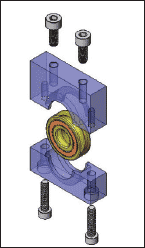There’s nothing new about plastic as a substitute for other materials. From its very beginnings, plastic took the place of whalebone, tortoiseshell, wood, and stone. The reasons for substitution were simple: availability and cost. Mixing up a vat of combustible celluloid had its risks, but they were small compared to those of hunting whales in tiny boats. Plastics were cheap compared to the semiprecious stones they replaced in costume jewelry, and they were easier to work than wood or stone.
| Today, plastic still makes financial sense, but it often replaces other materials on the basis of performance as well. In the example shown here (Figures 1 & 2), a single plastic part replaced seven metal components: top and bottom brackets, a bearing assembly, and four screws. The part, a clip-in shaft bearing, carries the rotating paper-feed shaft in a printer. To be molded as a single part, it had to be totally redesigned, not just to ensure functionality, but for manufacturability as well. It had to be reinforced to support the stresses created by side loads on the shaft. To allow molding in a simple two-part mold, the new design had to eliminate undercuts. The part was designed with relatively constant wall thickness to avoid sink, voids and warp. And it had to be drafted to facilitate ejection from the mold. But the resulting part was lighter, less expensive, maintenance free and required no assembly. |
Figure 1 |
Figure 2 |
Of course every conversion is different. In some cases, a single metal part might have to be broken into two or more for production in plastic. These could then be joined by molded-in snaps or clips, by welding, or with connectors. Plastic parts may require ribs or other reinforcements in order to withstand stresses. And they might require specific resins in order to perform their functions. For example, a part requiring metal-like strength might be made of carbon, Kevlar, or glass-filled resins.
Of course metal isn’t the only material being replaced with plastic.


Actual food is being widely replaced with plastic display dishes in restaurants, and as many a disappointed fish can attest, living creatures, from minnows to frogs to earthworms, are now being replaced with live-looking and live-smelling plastic fishing baits.
In describing the plastic part pictured opposite in Figures 1 & 2, we said that the molded part had replaced seven metal parts. In fact, one of those metal parts was a bearing assembly consisting of races, a cage and individual balls. So with the ball bearings gone, what reduces friction? The plastic itself.
It’s a rare plastic that can take the place of an engineered metal bearing assembly, but RTP 200 AR 15 TFE 15 does the trick in this application. Offered by RTP Company and consisting of 15 percent aramid fiber for strength and abrasion resistance, 15 percent PTFE for lubricity, and 70 percent Nylon 6/6, it is a very specialized plastic. But it did its job of replacing metal admirably. Not only did it provide a low friction bearing surface for the printer’s metal shaft, but it proved so durable that, over time, the steel shaft wore before the plastic bearing did.
This is just one example of the extremes to which plastic resins have been engineered. Other examples include:
Other resins boast different sorts of unique characteristics.